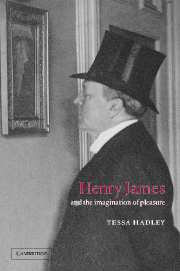Book contents
- Frontmatter
- Contents
- Acknowledgements
- Introduction
- 1 ‘Just you wait!’: reflections on the last chapters of The Portrait of a Lady
- 2 ‘As charming as a charming story’: governesses in What Maisie Knew and ‘The Turn of the Screw’
- 3 ‘The sacred terror’: The Awkward Age and James's men of the world
- 4 Blushing in the dark: language and sex in The Ambassadors
- 5 Poor girls with their rent to pay: class in ‘In the Cage’ and The Wings of the Dove
- 6 ‘A house of quiet’: privileges and pleasures in The Golden Bowl
- Notes
- Bibliography
- Index
2 - ‘As charming as a charming story’: governesses in What Maisie Knew and ‘The Turn of the Screw’
Published online by Cambridge University Press: 22 September 2009
- Frontmatter
- Contents
- Acknowledgements
- Introduction
- 1 ‘Just you wait!’: reflections on the last chapters of The Portrait of a Lady
- 2 ‘As charming as a charming story’: governesses in What Maisie Knew and ‘The Turn of the Screw’
- 3 ‘The sacred terror’: The Awkward Age and James's men of the world
- 4 Blushing in the dark: language and sex in The Ambassadors
- 5 Poor girls with their rent to pay: class in ‘In the Cage’ and The Wings of the Dove
- 6 ‘A house of quiet’: privileges and pleasures in The Golden Bowl
- Notes
- Bibliography
- Index
Summary
In a review of a children's novel in 1875 Henry James complained:
It is evidently written in good faith, but it strikes us as a very ill-chosen sort of entertainment to set before children. It is unfortunate not only in its details, but in its general tone, in the constant ring of the style. The smart satirical tone is the last one in the world to be used in describing to children their elders and betters and the social mysteries that surround them … Miss Alcott … goes too far, in our opinion, for childish simplicity or paternal equanimity. All this is both poor entertainment and poor instruction. What children want is the objective, as the philosophers say; it is good for them to feel that the people and things around them that appeal to their respect are beautiful and powerful specimens of what they seem to be. Miss Alcott's heroine is evidently a very subjective little girl, and certainly her history will deepen the subjective tendency in the little girls who read it.
It would be stretching a point to pretend that this description of Louisa May Alcott's Eight Cousins exactly fits What Maisie Knew, the novel that James himself wrote twenty-two years later. Maisie is at great pains never to be ‘smartly satirical’, and of course although its subject is a child it was not written for a child to read.
- Type
- Chapter
- Information
- Henry James and the Imagination of Pleasure , pp. 40 - 64Publisher: Cambridge University PressPrint publication year: 2002



